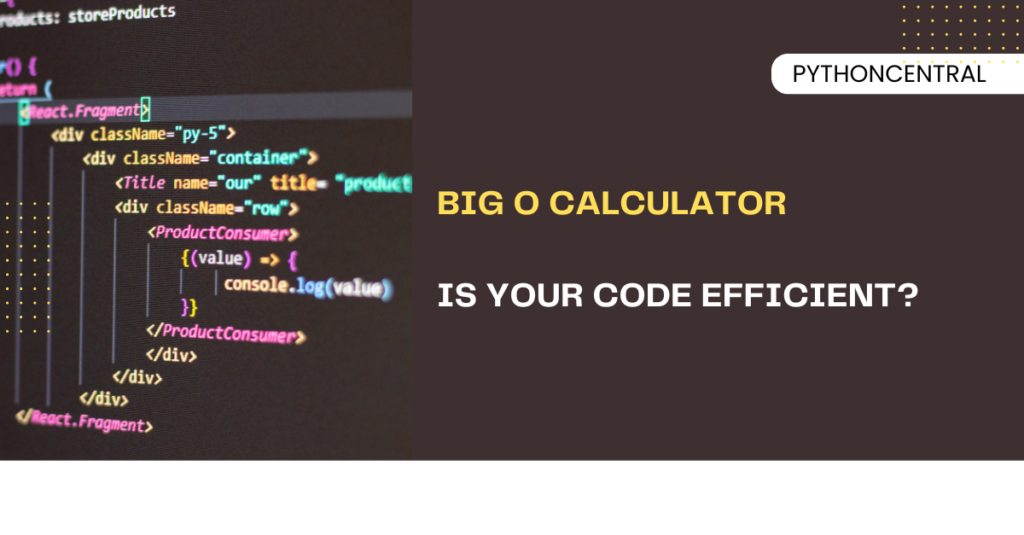Anybody can write code. That is the beauty of code. But with time, we should start writing code that is efficient and beautiful. Since technology has come a long way, there are dedicated tools and calculators that tell us if our algorithms are efficient. One such calculation method is the Big O notation. Understanding algorithmic efficiency is important because it shows if your code performs in tricky conditions as well.
Today at PythonCental, let us explain how you can evaluate your algorithmic complexity using Big O calculator in Python. This is helpful for beginners and also to seasoned developers. By the end of this detailed guide, you will have an enhanced understanding of performance analysis and can write optimized code. Get. Set. Learn!
What is Big O Notation?
The Big O notation is a mathematical concept used in computer science to describe the worst-case time or space complexity of an algorithm. In simpler words, the Big O notation answers the question "how does the performance of this algorithm scale with input size?".
Here are some common Big O classes:
- O(1): Constant time
- O(log n): Logarithmic time
- O(n): Linear time
- O(n log n): Log-linear time
- O(n²), O(2ⁿ), etc.: Quadratic and exponential time
Why Should You Use a Big O Calculator?
With a Big O calculator you can analyse your code by:
- Estimating time and space complexity
- Identifying inefficient code segments
- Comparing algorithm performance
- Teaching beginners how performance relates to structure
While fully automated Big O calculators are limited, there are tools and techniques that can help you with approximate complexity.
Manual Complexity Analysis in Python
Let us evaluate a basic example:
def linear_search(arr, target): for i in arr: if i == target: return True return False
Time Complexity: O(n)
The loop runs once for each element.
Space Complexity: O(1)
Uses constant memory regardless of input size.
Using Python Tools for Complexity Estimation
Let us learn some Python tools for complexity estimation now.
How to Use timeit for Runtime Measurement
Here is how you can use timeit for measuring the script runtime
import timeit code_to_test = ''' arr = list(range(10000)) linear_search(arr, 9999) ''' print(timeit.timeit(stmt=code_to_test, globals=globals(), number=100))
Though this won’t give Big O directly, but you can infer complexity by running tests with varying input sizes.
Using big-O-calculator Third-party Tools
While Python does not provide a built-in Big O calculator, you can use third-party tools like:
- Big O Calculator (Web)
- pycomplexity (Python package and experimental)
These tools analyse patterns and offer complexity hints but still require critical validation.
Practical Examples of Algorithm Analysis
Sample Algorithm: Nested Loops
Let us take an example algorithm that uses nested loops:
def print_pairs(arr): for i in arr: for j in arr: print(i, j)
Time complexity O(n²): Every element is compared with every other.
Sampe Algorithm: Binary Search
Now, let us take the example with binary search.
def binary_search(arr, target): low, high = 0, len(arr) - 1 while low <= high: mid = (low + high) // 2 if arr[mid] == target: return True elif arr[mid] < target: low = mid + 1 else: high = mid - 1 return False
- Time complexity: O(log n)
- Space complexity: O(1)
Best Practices When You Use Big O Calculators
- Always combine theoretical knowledge with real benchmarking.
- Try to simplify loops and recursive calls
- Avoid unnecessary data structure conversions
- Use Python built-ins like set and dict, which offer O(1) lookups
Some Common Mistakes You Have to Avoid
- Confusing best-case and worst-case
- Ignoring the effect of input data on branching
- Overestimating impact of constants in Big O (e.g., 2n vs. n)
Wrapping Up
A good developer writes code that works but a great one writes code that scales. By using a Big O calculator, practicing manual analysis, and understanding complexity, you can learn to elevate your ability to design performant applications in Python.
Big O notation isn't just academic. It is an indication to see how your code behaves under stress. Whether you’re preparing for interviews or writing production systems, learning how to analyse algorithmic efficiency is a must.

